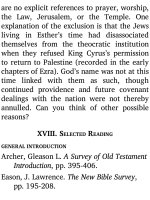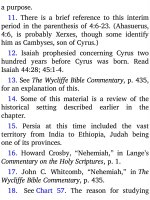Jensens survey of the old testament adam 418
Bạn đang xem bản rút gọn của tài liệu. Xem và tải ngay bản đầy đủ của tài liệu tại đây (116.78 KB, 4 trang )
Even nature itself echoed this, with the
darkening of the sun and the violent
earthquake (Matt. 27:51; Luke 23:45).
John’s account of Jesus’ death is brief but
weighty. He paints six portraits, identi ed
below:
Identity recognized 19:17-22
Goods confiscated 19:23-24
Mother cared for
19:25-27
Life given
19:28-30
Death verified
19:31-37
Body buried
19:38-42
G. RESURRECTION CHAPTER (20:1-31)
The resurrection of Jesus was both
prescheduled
of
His
Father
and
unanticipated by the disciples. Jesus had
clearly instructed His disciples earlier about
His forthcoming death and resurrection
(Matt. 16:21; Mark 8:31; Luke 9:22), but
they did not understand the meaning then,
nor did they even remember the words later.
Understanding
would
come
through
believing, and believing would come
through signs. John 20 records some of the
signs that restored the disciples to Jesus in a
personal and new relationship to Him as the
risen Lord. How utter defeat can suddenly
and miraculously turn to victory is one of
the glowing truths of this chapter.
Recall 20:30-31. The word signs is a key
word of the verses. What signs are recorded
in John 20? Observe in the chapter how
often the word see (and related words)
appears in the chapter.
V. KEY WORDS AND VERSES
Read again the list of key words shown on
Chart 46, page 187. Add to the list the other
key words that you have observed. Note also
the key verses indicated on the chart: 20:3031. There are other key verses in John. Did
you observe any in the course of your
survey?
VI. APPLICATIONS
1. Why is belief in the deity of Christ a
key ingredient of saving faith?
2. When is your faith in Christ as miracle
worker the strongest? How would you
describe the healthy faith-life?
3. Christ is the believer’s interceding High
Priest. How does this truth a ect your daily
life as a Christian?
4. What does Christ’s interest in individual
persons teach you?
VII. REVIEW QUESTIONS
1. Describe John’s home background and
his character. What was his approximate age
at death?
2. What New Testament books did John
write?
3. When and where was the fourth gospel
written?
4. Who were the original readers?
5. What is the purpose of this gospel?
6. Compare this gospel account with the
synoptic gospels.
7. Did John report more of Jesus’ rst or
second year of public ministry?
8. What is the prologue (1:1-18) about?
9. What is “The Great Pause” of John?
10. Complete the ve-point outline of
John beginning with Era of incarnation
begins.
11. Name three key words.









